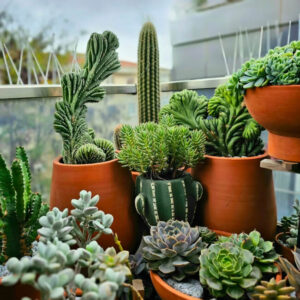The best flowers for bees come in many shapes, sizes and colours. Australia is spoiled with a large variety of introduced and native flowering plants that can not only help our bees thrive but can also serve as fantastic ornamental additions to our gardens.
We listed 10 of our top picks to help you choose which flowers to grow you create a bee-friendly garden.
More...
Why is it Important to Grow Flowers for Bees in Your Garden?
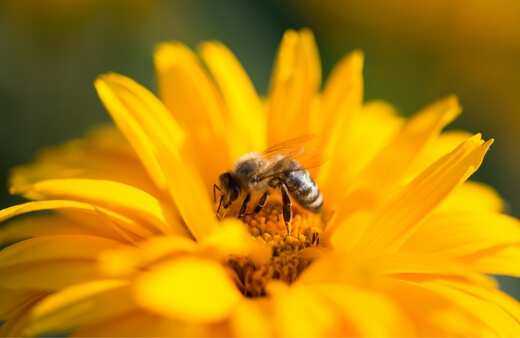
With bee numbers swiftly declining globally and urbanisation consistently decreasing the mass of flowered landscapes, it has become more important than ever for us to create harmonious and nurturing environments for bees in our yards.
The best way to do this is to create a bee-friendly garden by populating your outdoor spaces with flowers that will help boost their numbers and provide them with essential sources of pollen and nectar.
Nurturing and keeping bees is a great way to help pollinate your flowers, allowing them to bloom and be healthy. While your primary purpose might be to help your garden, you can also harvest your honey simultaneously. You don't have to be experienced to start. Anyone can start beekeeping, provided that you have the right beekeeping kit.
Setting up backyard beehives alongside your flowers will ensure you cultivate the most harmonious environment possible for our flying friends. It can seem a little overwhelming when trying to pick the best flowers for bees as there are so many excellent options to choose from throughout Australia.
Whatever the size or setting of your garden, you’re bound to find a few fantastic flowering plants that will certainly make a difference.
Some Benefits of Bringing Bees to our Backyards
- Bees are perfectly adapted to pollinate and help our plants grow.
- The array of flowers will add splashes of colour and texture to your outdoor spaces.
- Your valuable contribution will support local and national bee populations for both introduced and native bees.
- More bees mean more pollination occurring with our native plants, keeping our diversity in check.
10 Best Flowers for Attracting Bees
1. Bottlebrush (Callistemon)
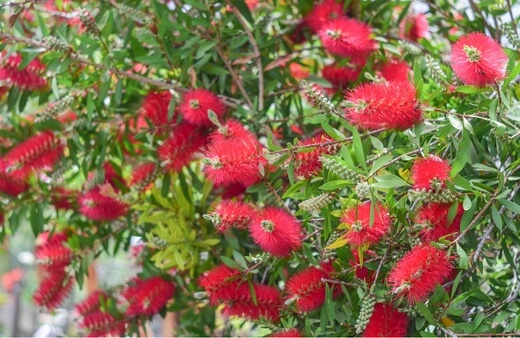
This genus of shrubs provides an abundance of bright red, brush-like blooms to a wide range of native bee species as well as nectar-feeding avifauna. These native plants are hardy and well-adapted to our endemic conditions so they are fast-growing and easy to maintain.
Bottlebrushes are small to large shrubs that make for excellent ground cover, hedges or screens, or even as a feature specimen.
Find out the most popular varieties of callistemons and how to grow them here.
2. Daisies – Many Varieties Available
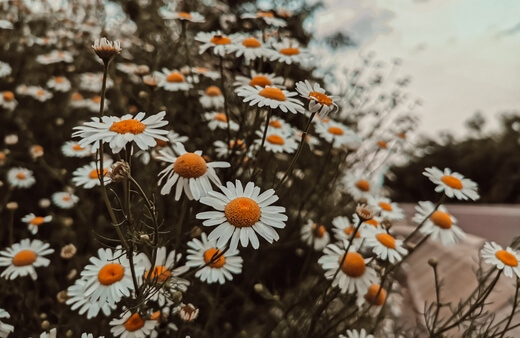
These shallow, open and long-lived blooms can provide easily accessible nectar and pollen to all species of bees, both short and long-tongued. They are an excellent choice for any garden and will produce flowers even outside of the usual springtime blooms, giving the bees long-lasting supplies.
Daisies are compact, low-growing, hardy shrubs that are perfect for smaller spaces.
Popular varieties of daisies for bees include:


Get Your Free Guide:
Master Growing Australian Natives eBook
A Must Have Complete Guide for Every Australian Garden
Get Your Free Guide:
Master Growing Australian Natives eBook
A Must Have Complete Guide for Every Australian Garden
- Cut-leaf daisy – Brachyscome
- Everlasting daisy – Bracteantha
- African daisy – Osteospermum
- Seaside daisy – Erigeron
3. Lavender (Lavandula)

Another fantastic genus of flowering plants for bees, lavenders produce a wealth of purple flower spikes that are extremely attractive to both Blue Banded Bees and our native bees. These compact and hardy shrubs provide bees with an abundance of nectar and will flower for almost the entire year.
Lavenders will fill your garden with their wonderful scent while giving the bees everything they need. Other herbaceous members of this family like basil, thyme, rosemary and mint are also very popular with all bees.
Here are more details to growing and caring for lavender may it be indoors or outdoors.
4. Native Rosemary (Westringia fruticosa)
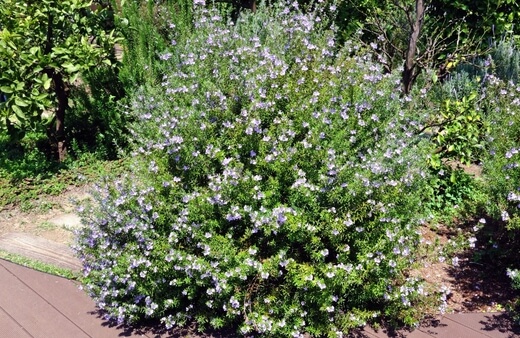
These tidy and hardy shrubs produce masses of gorgeous white blooms that last throughout most of the year. The flowers are particularly attractive to long-tongued bee species like Blue Banded Bees and Teddy Bear Bees.
The long-lasting blooms can provide a reliable and accessible supply of nutrients to bees over a long period. There are a few excellent cultivars of Westringia available from native plant nurseries so you’re bound to find the right variety for you.
Here is our comprehensive guide to growing Westringia fruticosa.
5. Grevillea ‘Pink Surprise’ and Grevillea ‘Moonlight’
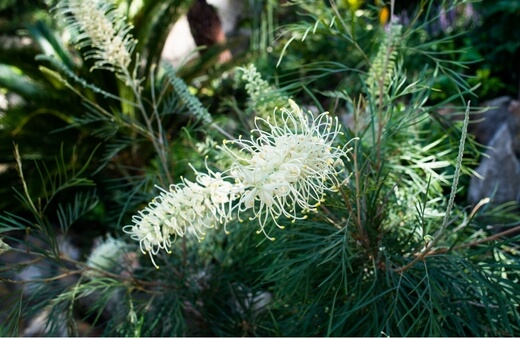
Both of these hybrid grevillea varieties are great picks for enticing bees to your garden. They are very decorative shrubs that produce a wealth of long-lasting flowers with an abundance of nectar for our bees.
Grevilleas will attract a wide range of native bees, honeybees and nectar-feeding birds. Ranging in size and form from tall shrubs to smaller, more prostrate varieties, these plants can easily suit any garden situation.
Being a very low-maintenance genus of plants, grevilleas are perfect for any grower regardless of skill level. Follow our complete guide to growing Grevillea ‘Moonlight’.
6. Purple Coral Pea (Hardenbergia violacea)
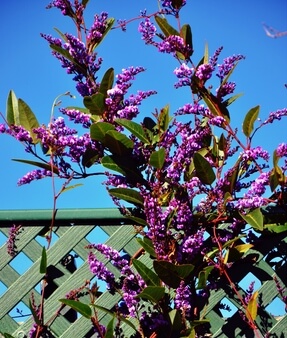
This plant is a huge hit with bees as it features large clusters of delicate dark-purple blooms atop lush leathery leaves. It will flower over winter and spring with sprays of eye-catching blooms for our local bees.
Being a hardy climbing plant, it’s the perfect pick for those who have the space and desire to establish an ornamental climber in their landscapes. There are also more upright forms available, some even sporting washes of white blooms.
Click here to find out what are the best growing conditions for Hardenbergia violacea.
7. Pincushion Hakea (Hakea laurina)
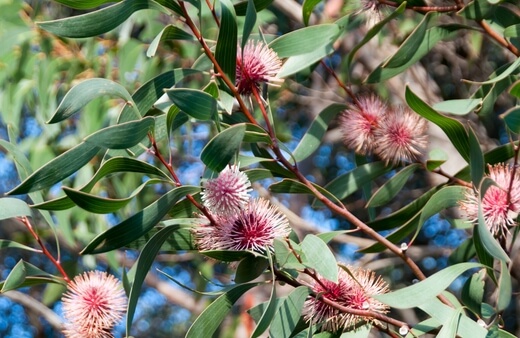
Admired by growers and bees for its stunning pinkish-red, spidery blooms, this luscious native is a particular favourite among stingless bees. The notorious flowers last between April and August and this plant also sports lovely blueish-green foliage.
These highly ornamental plants can be grown as shrubs or trees so they can make for wonderful additions to any garden.
8. Butterfly Bush (Buddleja or Buddleia)

Butterfly bush are tall shrubs that produce clusters of gorgeous conical violet to pink blooms that are very attractive to many types of bees including but not limited to Leafcutter Bees, Reed Beed and Blue Banded Bees.
Even the shiny-green foliage is enjoyed by some species of bees. This plant is considered a weed in some territories so be sure to check if you are permitted to establish one in your area before planting.
9. Red Flowering Gum (Corymbia ficifolia syn. Eucalyptus ficifolia)

Another excellent pick for smaller gardens, red flowering gums are small-growing trees that produce vivid sprays and displays of bright-red to pink flowers in the springtime that make for a great source of food for many of our local bees.
This tree is one of the most commonly planted ornamental eucalyptus so you can be sure it will add a wonderful impression to your outdoor spaces.
Refer to our guide to growing and caring for Corymbia ficifolia.
10. Sunflowers (Helianthus)
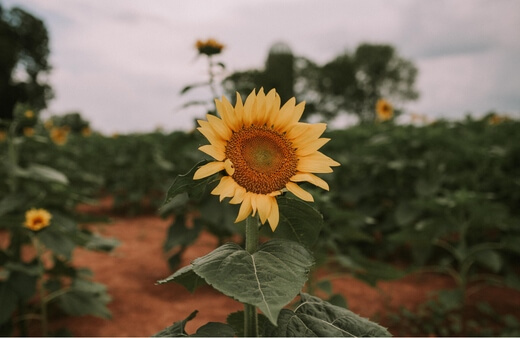
There’s a reason these famous flowers are so synonymous with bee-friendliness. Sunflowers are one of the first plants thought of when considering the best flowers for bees. They are easy to grow from seeds and will bloom throughout the summer and into autumn.
The large yellow sunflower blooms are made up of thousands of tiny flowers bunched tightly together, providing an abundance of pollen and nectar to visiting bees. These beautiful plants will suit any garden.
Quick Tips for Growing the Best Flowers for Bees
- Installing beehives alongside the flowers in your garden will quickly take your bee-friendly efforts to the next level.
- Avoid using pesticides as you can kill many beneficial insects including bees.
- Maintain multiple water sources around your garden.
- It is best to plant as wide a variety of flower shapes and sizes as you possibly can to cater to the large diversity of bees and to provide food throughout the year.
- Longer-flowering plants will always be beneficial, especially if you don’t have the space for mass plantings and can only establish a couple of flowers.
- Watch out for some hybrid varieties as many of them are crafted more for aesthetics and can lose their intense natural scents and nectar that attract our bee populations.
The Best Flowers for Bees – In Conclusion
As you can see, it’s not difficult to help our prolific pollinators from the comfort of our gardens. Regardless of the size or setting of your backyard, there’s bound to be a wonderful flowering plant that will fit your needs so you can still make a difference.
Whether potted, planted in your beds or on your balcony, you can always find the right fit.
By planting some of the best flowers for bees, you can take advantage of a win-win situation wherein you’ll be adding lovely tones of colour to your outdoor spaces and the bees will certainly be thanking you for that!
Published on November 10, 2022 by Maisie Blevins
Last Updated on September 20, 2025

